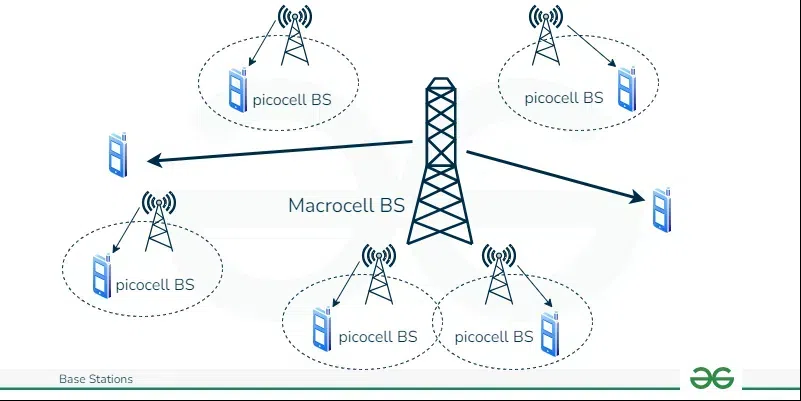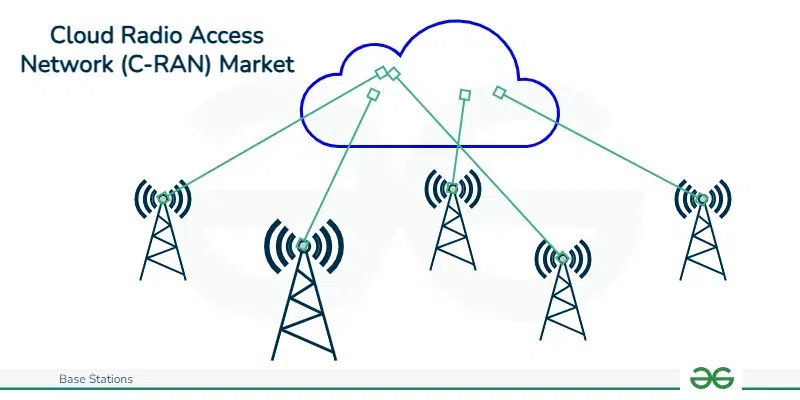Types of Base Stations
Last Updated :
09 May, 2024
Base stations are one of the widely used components in the field of wireless communication and networks. It is an access point or base point of a particular area for network accessibility. In this article, we will discuss the different types of base stations with their advantages and applications in the real world.
Base Station
A base station is a component that provides functionality as a gateway for any wireless device to communicate or access the network within a particular area. It provides connectivity between devices to devices or devices to network for network accessibility in all the available devices efficiently. Also, base stations contain transceiver to get the functionality of sending and receiving the wireless communication signals.
Types of Base Stations
Some basic types of base stations are as follows:
- Macro Cell Base Stations
- Pico Cell Base Station
- Femto-cell base station
- Remote Radio Heads (RRH)
- Cloud Radio Access center
- Mobile switching center
Macro Cell Base Stations
Macro-base stations are tall towers ranging from 50 to 200 feet in height, placed at strategic locations to provide maximum coverage in a given area. Those are equipped with large towers and antennas that transmit and receive radio signals from wireless devices.
In the US, there are over 417K cell sites as of 2020. 5G base stations feature advanced active antenna systems with multiple antennas in MIMO configuration, resulting in higher transmission and reception capacity, faster data transfer speeds, and better RF power delivery. Base stations with fewer than 16 antennas are considered macro base stations, while those with 16 channels or more are large MIMO base stations.

Macro Base Station
Advantages of Macro Cell Base Stations
- Wide Coverage Area
- High Capacity
- Improved Signal Quality
- Interference Management
- Scalability
Applications of Macro Cell Base Stations
- Urban and Suburban Coverage
- High-Capacity Communication
- Wide-Area Connectivity
- Interference Management
- Frequency Reuse
- Supports Multiple Technologies
Pico Cell Base Station
A Pico cell base station is a small wireless tower that provides improved phone and Internet services to local areas such as homes or small offices; More specifically for specific rooms. It is a very small, low-power station that works like a personal signal booster that improves call and Internet quality in limited space.
It links to the Internet and provides a small pocket of high signal strength only for your device, ensuring that the connection will be more reliable when you are in the small area where it is installed. This is useful for areas with poor network reception or high interference – it provides a stronger and more reliable signal for your phone calls and Internet use within its reach.

Pico Cell Base Station
Advantages of Pico Cell Base Stations
- Improved Coverage in Dense Areas
- Increased Capacity
- Cost-Effective Deployment
- Enhanced Indoor Coverage
- Reduced Interference
- Quick Deployment
Applications of Pico Cell Base Stations
- Urban Areas
- Indoor Environments
- Hotspots and Public Venues
- Enterprise Solutions
- Residential Areas
- Event Coverage
Femto-Cell Base Stations
Femto-base station (commonly known as access point base station, femtocell or HHP), is an in-home base transceiver system. Like a normal base station, it connects the phone’s voice and data to the cell network but covers a smaller scale (home).The advantage of using a femto-base station is that it frees up cell tower traffic for the service provider.
The unit provides superior signal strength to customers, primarily where the cellular signal is weak or not available due to the proximity of the unit. Femto-base stations extend general networks and mimic general telecommunication infrastructure. VoIP over the Internet provides connection to the cell phone network.

Femto Cell Base station
Advantages of Femto-Cell Base Stations
- Enhanced Indoor Coverage
- Improved Voice and Data Quality
- Offloading Network Traffic
- Quick and Easy Deployment
- Increased Security
Applications of Femto-Cell Base Stations
- Residential Areas
- Small Businesses
- Remote Areas
- Mobile Network Offload
- Personal Network Coverage
Remote Radio Heads (RRH)
The base station’s RF circuitry is housed in a small outdoor module known as a remote radio head (RRH) or remote radio unit (RRU). RRH performs all RF functions such as transmit and receive functionality, filtering and amplification. It also has analog-to-digital or digital to analog and digital upconverters.
Alternatively, an RRH can allow operators to optimize performance from a remote centralized location with advanced monitoring and control features. It is mounted close to the antenna and connected to the main digital part of the base station (BBU) through an optical fiber.

Remote Radio Heads
Advantages of Remote Radio Heads (RRH)
- Reduced Signal Loss
- Improved Network Flexibility
- Cost-Efficient Deployment
- Energy Efficiency
- Better Network Performance
Applications of Remote Radio Heads (RRH)
- Distributed Antenna Systems (DAS)
- Small Cell Deployments
- Rural and Remote Areas
- Mobile Network Densification
- Mobile Edge Computing (MEC)
Cloud Radio Access Network
The state of cellular networks is reconsidered from one’s mind, as almost all complex functions located in base stations are transferred to the clouds. Unlike traditional base stations, where all processing is performed by separate sites, C-RAN centrally involves the cloud data center in executing the baseband process. In a C-RAN deployment, the BBUs are separated from the radio units and combined into a hub. All the complex signal processing, coordination and management for multiple RRHs scattered through different sites of the cell is done by this centralized BBU pool.

Cloud Radio Access Network
Advantages of Cloud Radio Access Network
- Network Centralization
- Cost Savings
- Energy Efficiency
- Flexible Resource Allocation
- Simplified Network Maintenance
- Interference Management
Applications of Cloud Radio Access Network
- Distributed Antenna Systems (DAS)
- Mobile Edge Computing (MEC)
- Network Densification
- Efficient Resource Utilization
- Cloud-based Services
Mobile Switching Centers
The Mobile Switching Centers (MSCs) are one of the most important base station network , as they act as the central point for call routing and management. Unlike base stations, which deal with direct communications between mobile devices and towers, Mobile Switching Centers (MSCs) oversee the routing of calls and data over various cellular networks to ensure that your call reaches its intended receiver.
Think of Mobile Switching Centers (MSCs) for traffic control for cellular networks. When you make a call or use data on your mobile device the signal travels to the nearest base station. From there, the MSC takes over and redirects this call or data to its desired destination. Mobile Switching Centers (MSCs)are responsible for functions such as authentication of users, regulating handovers between different base stations while you roam, etc. – routing calls or messages to other networks whenever needed.

Mobile Switching Center
Advantages of Mobile Switching Centers
- Call Routing and Switching
- Handover Support
- Subscriber Management
- Roaming Support
- Interconnectivity with Other Networks
Applications of Mobile Switching Centers
- Core Network Element
- Voice and Data Services
- Location Management
- Global System for Mobile Communications
- Universal Mobile Telecommunications System
Conclusion
As per the different types of base stations applications, all types play crucial role according to their functionality. And their functionalities are fruitful in the area of wireless telecommunication. All the types of base stations provide functionalities according to the given areas whether it is urban or residential, scalability, size of business, etc.
Types of Base Stations – FAQs
What is the main function of the base station?
Base stations are one of the widely used components in the field of wireless communication and networks. It is an access point or base point of a particular area for network accessibility.
What is the another name of base station in networking terms ?
A base station is also known as a wireless router because it is act like a gateway for connectivity of multiple devices or networks.
What is the use of base station?
A base station is used as a gateway or access point for wireless devices or network in a particular area.
Share your thoughts in the comments
Please Login to comment...